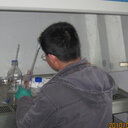A polysaccharide fraction of adlay seed (Coixlachryma-jobi L.) induces apoptosis in human non-small cell lung cancer A549 cells.
Avainsanat
Abstrakti
Different seed extracts from Coix lachryma-jobi (adlay seed) have been used for the treatment of various cancers in China, and clinical data support the use of these extracts for cancer therapy; however, their underlying molecular mechanisms have not been well defined. A polysaccharide fraction, designated as CP-1, was extracted from the C.lachryma-jobi L. var. using the ethanol subsiding method. CP-1 induced apoptosis in A549 cells in a dose-dependent manner, as determined by MTT assay. Apoptotic bodies were observed in the cells by scanning electronic microscopy. Apoptosis and DNA accumulation during S-phase of the cell cycle were determined by annexin V-FITC and PI staining, respectively, and measured by flow cytometry. CP-1 also extended the comet tail length on single cell gel electrophoresis, and disrupted the mitochondrial membrane potential. Further analysis by western blotting showed that the expression of caspase-3 and caspase-9 proteins was increased. Taken together, our results demonstrate that CP-1 is capable of inhibiting A549 cell proliferation and inducing apoptosis via a mechanism primarily involving the activation of the intrinsic mitochondrial pathway. The assay data suggest that in addition to its nutritional properties, CP-1 is a very promising candidate polysaccharide for the development of anti-cancer medicines.



